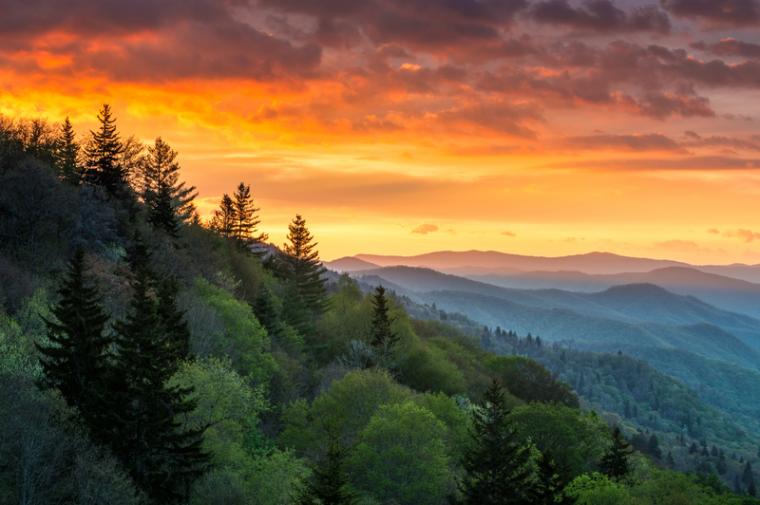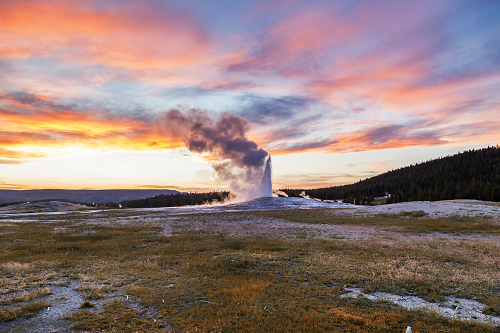

At least six national parks set attendance records in 2021, led by Yellowstone National Park.The park — which is mostly in Wyoming but also includes parts of Idaho and Montana — welcomed more than 4.8 million visitors last year. That’s up more than 1 million (or 28 percent) from 2020, making 2021 the park’s busiest year ever. May, June, July, August and September were all record months, with the number of visitors in July exceeding 1 million for the first time.
As of Feb. 1, the National Park Service had not released official visitation numbers for all parks, but individual parks that announced record-breaking years include Acadia National Park in Maine (2.75 million visitors), Arches National Park in Utah (1.8 million), Glacier National Park in Montana (3 million), Grand Teton National Park in Wyoming (3.8 million) and Great Smoky Mountains National Park in North Carolina and Tennessee (14.1 million).
Yellowstone completed more than $100 million in projects over the past two years to improve transportation infrastructure, reduce traffic congestion and enhance visitor experiences, according to NPS officials, with substantial additional investments slated to continue in 2022 and 2023 in multiple areas of the park, as part of funding received from the Great American Outdoors Act.
“Parks ranging from Arches to Yellowstone smashed monthly records throughout last year,” Kati Schmidt of the National Parks Conservation Association told CNTraveler.com, citing increased interest in outdoor activities amid the pandemic.
As a result, at least eight national parks — including Arcadia, Arches and Glacier — will begin requiring reservations and/or timed-entry tickets in 2022 as a crowd-control measure.
“We’re not trying to limit visitation; we’re just trying to distribute it,” Kait Thomas, spokesperson for Arches National Park, told the Associated Press in December, referring to the new timed-entry tickets visitors will be required to purchase for access between 6 a.m. and 5 p.m. daily from April through October. Tickets will be available for up to 2,700 vehicles per day, which is about the average number of visitors on a busy day in 2019, according to Thomas.
Visitation at Arches soared 66 percent over the past decade, the AP reports, forcing park officials to close the gates for hours at a time to delay entry.
Increased attendance is prompting changes at smaller national parks, too. At Death Valley National Park, which straddles California and Nevada and is the hottest, driest and lowest of the national parks, officials have proposed improvements to utilities, roads, parking areas, campgrounds and buildings.
“Park visitation has increased substantially, and people’s interests and expectations have changed,” acting Superintendent James Woolsey said in a statement. “These proposed projects will repair failing infrastructure and enhance visitor experiences.”
Indiana Dunes National Park, in Indiana, will begin charging an entrance fee this year for the first time in its 55-year history.
According to the South Bend Tribune:
Back in August, when the park was seeking feedback on the then-proposedfees, Superintendent Paul Labovitz had said the revenue would help to pay for a backlog of more than $30 million in maintenance, saying the park was “kind of beat up.”
And, in [the announcement confirming the fees], the park noted that the dollars also will help to build its portion of the Marquette Greenway, a collection of paved multi-use trails that will stretch 60 miles from Chicago to New Buffalo.
The fees come as the number of visitors has grown from 1.7 million to more than 3 million since the park changed the last word in its name from “Lakeshore” to “Park” in February of 2019, which did nothing to change the revenue it gets from the National Park Service.
While it remains to be seen how these changes — along with increasing visitor numbers — will impact running and cycling events at national parks, events owners might want to contact park officials and ask. Looking ahead and planning for unforeseen developments will be more critical than ever as NPS officials anticipate another year of potentially record-breaking attendance in the pandemic era.
Meanwhile, if you’re looking for a cheap vacation in 2022, NPS has declared all visitors will receive free admission on the following days: April 16 (which is the first day of National Park Week), Aug. 4 (the anniversary of the Great American Outdoors Act), Sept. 24 (National Public Lands Day) and Nov. 11 (Veterans Day).

